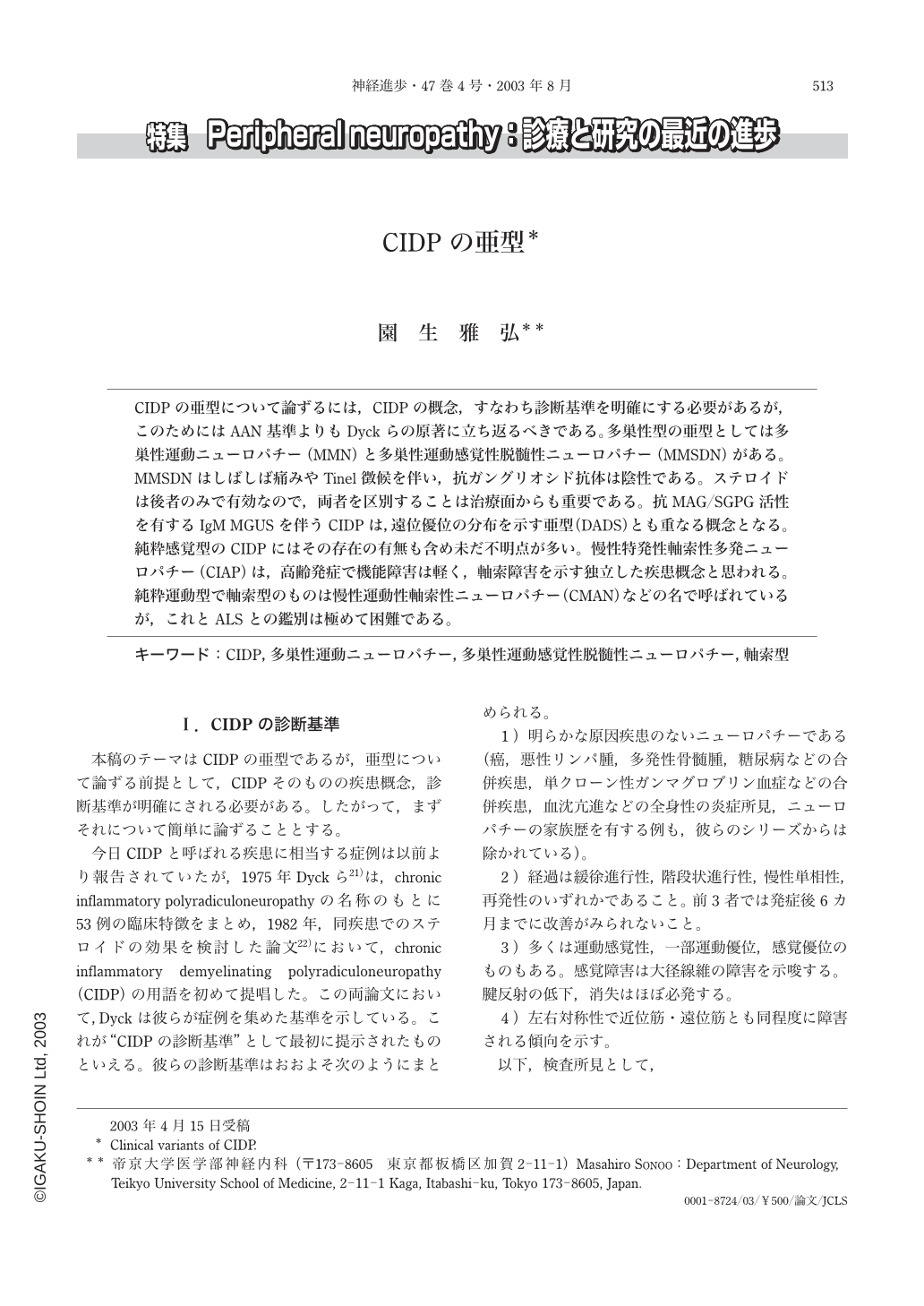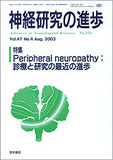Japanese
English
- 有料閲覧
- Abstract 文献概要
- 1ページ目 Look Inside
CIDPの亜型について論ずるには,CIDPの概念,すなわち診断基準を明確にする必要があるが,このためにはAAN基準よりもDyckらの原著に立ち返るべきである。多巣性型の亜型としては多巣性運動ニューロパチー(MMN)と多巣性運動感覚性脱髄性ニューロパチー(MMSDN)がある。MMSDNはしばしば痛みやTinel徴候を伴い,抗ガングリオシド抗体は陰性である。ステロイドは後者のみで有効なので,両者を区別することは治療面からも重要である。抗MAG/SGPG活性を有するIgM MGUSを伴うCIDPは,遠位優位の分布を示す亜型(DADS)とも重なる概念となる。純粋感覚型のCIDPにはその存在の有無も含め未だ不明点が多い。慢性特発性軸索性多発ニューロパチー(CIAP)は,高齢発症で機能障害は軽く,軸索障害を示す独立した疾患概念と思われる。純粋運動型で軸索型のものは慢性運動性軸索性ニューロパチー(CMAN)などの名で呼ばれているが,これとALSとの鑑別は極めて困難である。
In this article the author will discuss on various clinical variants of chronic inflammatory demyelinating polyradiculoneuropathy(CIDP). For this purpose, the concept or diagnostic criteria of CIDP must be clarified, because variants are no other than the reciprocal of the cardinal disease entity. AAN criteria(1991)are widely known as the diagnostic criteria of CIDP, but they were originally designed as the research criteria to select uniform cases for clinical trials. Many patients who do not meet the AAN criteria respond to immune therapy and are thought to be CIDP. A number of new diagnostic criteria that are useful for clinical decision making have been proposed, but the clinical criteria described in the original article of Dyck et al.(1975)should also be respected.
Multifocal variants of CIDP are composed of pure motor type and sensorimotor type. Multifocal motor neuropathy(MMN)with conduction block clinically mimics amyotrophic lateral sclerosis(ALS). Corticosteroids are ineffective and often worsen MMN. The efficacy of intravenous immunoglobulin(IVIg)has been documented by a number of randomized control trials. However, the improvement usually lasts only one to three months, and repeated administration becomes eventually necessary. Multifocal motor and sensory demyelinating neuropathy(MMSDN), first reported by Lewis et al.(1982)and reidentified by Oh et al.(1997), is characterized by shorter clinical course, frequent neuralgic pain or Tinel's sign, and negative anti-ganglioside antibodies. Corticosteroids, as well as IVIg, are effective for MMSDN. The distinction between MMN and MMSDN is important because treatment options are clearly different for these two groups. MMSDN is probably more akin to ordinary CIDP, but its recognition has a clinical value, because lists of differential diagnosis are different from ordinary CIDP, such as vasculitis, entrapment neuropathy or cervical radiculopathy.
CIDP accompanied by IgM MGUS(monoclonal gammopathies of undetermined significance)having anti MAG/SGPG antibody activity is characterized by senile onset, protracted course, sensory or sensorimotor involvement dominant in distal legs, conduction delay accentuated at the distal portion of the nerve, negative conduction block, and poor response to treatment. Distal acquired demyelinating symmetric neuropathy(DADS), proposed by Katz et al.(2000), significantly overlaps CIDP-MGUS.
The independence of pure motor variants of CIDP is questioned, because ordinary CIDP also has a tendency of motor predominance. Even the existence of pure sensory variants of CIDP is controversial, because many of the reported cases have motor conduction abnormalities and some patients have eventually developed motor symptoms.
“Axonal variants”of CIDP have been reported, but mere failure to fulfil the existing criteria for demyelination, such as those incorporated in the AAN criteria, cannot be the evidence for axonal pathology. Chronic idiopathic axonal polyneuropathy(CIAP), reported by Nottermans et al.(1993, 1994), is characterized by senile onset, protracted course, mild sensory or sensorimotor symptoms in distal legs, and axonal features in nerve conduction studies. Mere observation is recommended for CIAP because of poor response to treatments and mild functional impairment.
Pure motor and axonal variants have been reported under the name of lower motor neuron syndrome, chronic motor axonal neuropathy(CMAN), or axonal multifocal motor neuropathy. Electrophysiology cannot distinguish between motor neuropathy and motor neuronopathy(ALS). Reported cases have been diagnosed as such on the basis of pure lower motor neuron involvement, existence of anti-ganglioside antibodies(GM1, GalNAc-GD1a), trivial evidence for demyelination in conduction studies, or phenotype of MMN, i. e., protracted and asymmetric involvement dominant in hands:but finally by the favorable response to treatment such as IVIg or cyclophosphamide. Clinicians face difficulty in selection of treatment because most of such cases are refractory to expensive treatments and eventually prove to be ALS.

Copyright © 2003, Igaku-Shoin Ltd. All rights reserved.


